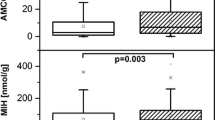Abstract
Objectives: The objectives of this study were␣threefold. First, to examine the hepatic effects of occupational exposure to 1,1,2-trichloro-1,2,2-trifluoroethane (FC 113) using conventional and newer tests (serum bile acids) of hepatobiliary function. Second, to assess the effects of altered work practices that included a reduced exposure to a different halogenated solvent (trichloroethylene) on the same parameters of liver function; and finally, to gather further data to support or refute the contention that serum bile acid (SBA) levels could provide a sensitive biological marker of exposure to these solvents. Design: Two groups of workers (control and exposed) in an Australian steel industry participated in the study. The exposed group (n = 5–6) comprised individuals who had either exposure to FC␣113 (68.2 ± 12.6 ppm) or trichloroethylene (8.9 ± 3.1 ppm) during the application of these solvents in a cleaning procedure, whereas the control group (n = 7–11) was composed of non-solvent-exposed office workers in the same company. The initial investigation involved exposure to FC 113 while a follow-up study was undertaken after changes in work practices were made including replacement of FC 113 with trichloroethylene (TRI). Methods: Standard liver function tests and individual serum bile acids (ISBA) were measured before and after exposure to solvents and simultaneously in the control subjects by enzymatic methods and high performance liquid chromatography (HPLC), respectively. Results: Statistical analysis of the data showed a significant increase in the concentration of total serum bile acids (TSBA), some of the subgroups of SBA, and a few of the ISBA in workers after a period of exposure to FC 113. After TRI replaced FC 113 together with other changes in work practices to give substantial reduction in exposure to solvent, a repeat study also found elevated SBA after the cleaning procedure but to a lesser extent. No other indications of adverse liver effects, as measured by conventional parameters of hepatobiliary function, were detected. Conclusion: Exposure to FC 113 was clearly associated with a significant rise in SBA levels, which are sensitive indicators of liver function. This finding is consistent with, and provides further support for, our previous investigations on chlorinated aliphatic hydrocarbon solvents which showed that SBA levels are a sensitive biological marker of exposure to these solvents. Changes in work practices including replacement of FC 113 resulted in a reduced effect on SBA, consistent with lower exposures.
Similar content being viewed by others
Author information
Authors and Affiliations
Additional information
Received: 22 October 1996 / Accepted: 21 February 1997
Rights and permissions
About this article
Cite this article
Neghab, M., Qu, S., Bai, C. et al. Raised concentration of serum bile acids following occupational exposure to halogenated solvents, 1,1,2-trichloro-1,2,2-trifluoroethane and trichloroethylene. Int Arch Occup Environ Health 70, 187–194 (1997). https://doi.org/10.1007/s004200050205
Issue Date:
DOI: https://doi.org/10.1007/s004200050205




